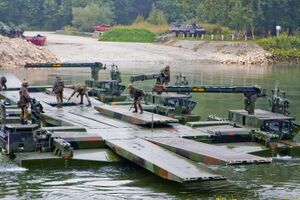Engineering:M3 Amphibious Rig
| M3 Amphibious Rig | |
|---|---|
 M3 of the German Army | |
| Type | Amphibious Bridging Vehicle |
| Place of origin | Germany |
| Service history | |
| In service | 1999[1] |
| Used by | See Operators |
| Wars | 2003 invasion of Iraq |
| Production history | |
| Designer | Eisenwerke Kaiserslautern (now General Dynamics European Land Combat Systems) |
| Designed | 1982-1990s |
| Manufacturer | General Dynamics European Land Combat Systems |
| Produced | 1994-present[2] |
| Specifications | |
| Mass | approx. 28 tonnes[1] |
| Length | 13.03 m (513 in)[3] |
| Width | 3.35 m (132 in) (side pontoons folded), 6.57 m (259 in) (side pontoons unfolded)[3] |
| Height | 3.97 m (156 in)[3] |
| Crew | 2-3 |
| Engine | Diesel 298kW[3] |
Operational range | 750 km (470 mi) (internal fuel)[3] |
| Speed | 80 km/h (50 mph) (on land), 14 km/h (8.7 mph) (on water)[3] |
The M3 Amphibious Rig is a self-propelled, amphibious bridging vehicle and ferrying vehicle that is used for the projection of tanks and other vehicles across water obstacles.
Development and service
Originally developed by the Germany firm Eisenwerke Kaiserslautern[1] (EWK, since 2002 acquired by General Dynamics European Land Systems), it succeeded the conceptually similar M2 made by the same company. Like its predecessor, the M3 traverses roads on its four wheels, deploying two large aluminium pontoons for buoyancy on water.
Development of the M3 began in 1982, with the final prototype being delivered 10 years later in 1992.[2] A first order of 64 serial vehicles was made in 1994,[2] and it entered service with the German and British armies[1] in 1996. Since then, the M3 has also been adopted by several NATO and allied nations.
Operating concept
The M3 is self-deployable by road, operating as a 4x4 wheeled vehicle with a maximum road speed of 80 km/h. For amphibious operation, two large aluminium pontoons are deployed, unfolding them along the length of its hull. The crew exits the vehicle cab to maneuver the pontoon using controls located on top of the hull. In water, the M3 is propelled and steered by 2 fully traversable pump jets at speeds of up to 14 km/h.[3]
Multiple rigs may be joined by long connectors called "ramps", 4 of which are carried on each vehicle, to form a bridge across a water obstacle. 8 M3 Rigs will bridge a 100m water gap this way, and can be traversed by vehicles up to and including the heaviest 60+ ton main battle tank like the Leopard 2A6 and Challenger 2. Alternatively, just 2 Rigs may be joined to create a ferry capable of carrying a similar load across much wider water gaps.
Combat history
Operation Telic
The M3 Amphibious Bridging Vehicle saw its first combat actions in Operation Telic, Britain's military operations in the Iraq War (until withdrawal in 2011). From 25 March 2003, 23 Amphibious Engineer Squadron, of 28 Engineer Regiment of the Royal Engineers ferried elements of 3 Commando Brigade across the Shatt Al-Basrah waterway,[4] enabling their continued advance on the Iraqi city of Basra.[5] A subsequent riverine crossing at the Rumaila oil fields was also undertaken by the M3. This action transported three AS90 self-propelled howitzers in support of 16 Air Assault Brigade of the British Army.[4]
Operators
Current
 Germany - German Army (operators have included Pionierbataillon 140 at Emmerich; now remains with 130th Armored Engineer Battalion (Panzerpionierbataillon 130)), 30 vehicles in service
Germany - German Army (operators have included Pionierbataillon 140 at Emmerich; now remains with 130th Armored Engineer Battalion (Panzerpionierbataillon 130)), 30 vehicles in service Indonesia - Indonesian Army
Indonesia - Indonesian Army Republic of China (Taiwan) - Republic of China Army
Republic of China (Taiwan) - Republic of China Army Singapore - Singapore Army
Singapore - Singapore Army United Kingdom - British Army
United Kingdom - British Army South Korea - South Korean Army[6]
South Korea - South Korean Army[6] Latvia - Latvian Army[7]
Latvia - Latvian Army[7] Sweden - Swedish Army[8][9]
Sweden - Swedish Army[8][9]
Future
See also
- M104 Wolverine
- M60 AVLB
- M1074 Joint Assault Bridge
- SAMUR Assault Bridge (TUR)
References
- ↑ 1.0 1.1 1.2 1.3 Global Defence - EWK
- ↑ 2.0 2.1 2.2 The Amphiclophy
- ↑ 3.0 3.1 3.2 3.3 3.4 3.5 3.6 "gdsbs.de". http://www.gdsbs.de/fileadmin/pdf/prospekt_m3.pdf. Retrieved 11 April 2015.
- ↑ 4.0 4.1 "www.britains-smallwars.com - Web site hosted by Freeola.com". britains-smallwars.com. Archived from the original on 15 August 2014. https://web.archive.org/web/20140815005617/http://britains-smallwars.com/gulf2/Weapon.html. Retrieved 11 April 2015.
- ↑ "Login Required - Once A Marine". onceamarinealwaysamarine.co.uk. http://www.onceamarinealwaysamarine.co.uk/539telic.htm. Retrieved 11 April 2015.
- ↑ "More details emerge about RoKA's acquisition of M3K amphibious rigs" (in en-US). https://www.janes.com/defence-news/news-detail/more-details-emerge-about-rokas-acquisition-of-m3k-amphibious-rigs.
- ↑ "GDELS to supply Amphibious Bridge and Ferry System to Latvia". 2021-12-22. https://www.shephardmedia.com/news/landwarfareintl/gdels-will-supply-amphibious-bridge-and-ferry-syst/.
- ↑ "Sweden orders interoperable bridging equipment". 2022-06-29. https://www.shephardmedia.com/news/landwarfareintl/sweden-orders-interoperable-bridging-equipment/.
- ↑ "FMV tecknar kontrakt på flytbroar" (in sv). Försvarsmaktens Materiel Verket. https://www.fmv.se/aktuellt--press/aktuella-handelser/fmv-tecknar-kontrakt-pa-flytbroar/.
- ↑ Stöckl, Benedikt (2023-03-15). "Dutch to send minehunters, drone detection systems to Ukraine" (in en-GB). https://www.euractiv.com/section/politics/short_news/dutch-to-send-minehunters-drone-detection-systems-to-ukraine/.
- ↑ "Ollongren zegt Oekraïne mijnenjagers toe bij bezoek aan gebombardeerde havensteden - Nieuwsbericht" (in nl-NL). Ministerie van Defensie. 2023-03-14. https://www.defensie.nl/actueel/nieuws/2023/03/14/ollongren-zegt-oekraine-mijnenjagers-toe-bij-bezoek-aan-gebombardeerde-havensteden.
External links
https://www.fnss.com.tr/tr/urunler/samur-seyyar-yuzucu-hucum-koprusu
 |



